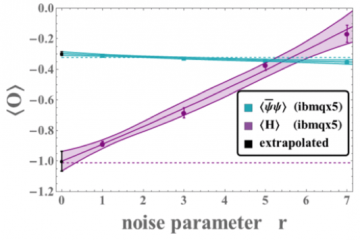
Achievement
Successfully simulated lattice QED model on IBM QPU. Part of this work used XACC
Significance and Impact
This work applies quantum computing to quantum field theory and leveraged the XACC programming framework.
Research Details
- Computed ground state energy of a 1+1d lattice using the Schwinger quantum field theory
- Results were within 1 % of theoretical value
- Implemented error mitigation protocols to enhance our results.
Overview
We present a quantum-classical algorithm to study the dynamics of the two-spatial-site Schwinger model on IBM's quantum computers. Using rotational symmetries, total charge, and parity, the number of qubits needed to perform computation is reduced by a factor of ∼5, removing exponentially large unphysical sectors from the Hilbert space. Our work opens an avenue for exploration of other lattice quantum field theories, such as quantum chromodynamics, where classical computation is used to find symmetry sectors in which the quantum computer evaluates the dynamics of quantum fluctuations.
Last Updated: May 28, 2020 - 4:05 pm